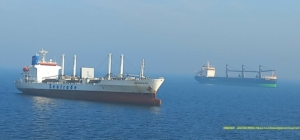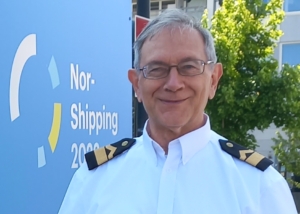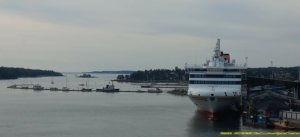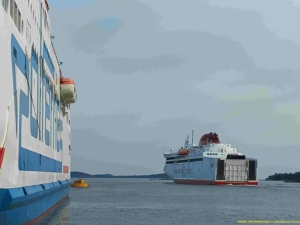A sailor and a passenger under the care of a satellite. From 2024, the safety of seafarers and ships will improve

 By Marek Grzybowski
By Marek Grzybowski
The profession of a seafarer on a merchant ship, fishing vessel, offshore vessel or tugboat in a port is still a dangerous profession. Passengers of cruisers, ferries and sailors sometimes also require assistance at sea. Not all maritime transport users know that they have been under the surveillance of satellite systems for many years, and even a single windsurfer can count on the location and assistance of sea rescuers or ship crews.
Satellite technologies and IT systems will cooperate even better with navigation systems from the beginning of next year. In order to increase safety at sea, two companies involved in the development of communications using space technologies have joined forces. Intellian Technologies of the Republic of Korea and Inmarsat Maritime, a Viasat company of the United Kingdom, have signed a Memorandum of Understanding (MoU) to establish a next-generation GMDSS security terminal for use on Inmarsat’s L-band ELERA network.
The safety of crews and passengers on over 100,000 commercial ships, approximately 4.1 million fishing vessels and several million larger and smaller yachts will increase. Intellian Technologies will provide satellite communication technologies and solutions, and Inmarsat Maritime will provide space-based systems. The new GMDSS safety terminal will better perform the functions described as the Global Maritime Distress and Safety System.

GMDSS ensures the safety of seafarers
Ships going to sea should meet the requirements of the GMDSS system. To meet them, they must have radiocommunication devices enabling the transmission of alarm signals using at least two independent devices. Each of them should use a different radio system enabling the transmission of information (transmitting and receiving alarm signals) from ship to land or in the land-ship relationship and between ships (units). These devices are intended to ensure the conduct and coordination of search and rescue of ships, lifeboats and survivors.
The new system will serve the safety of not only carriers. First of all, it will enable sailors, sailors, fishermen and passengers to swim safely in all conditions more efficiently than before.
According to UNCTAD, the fleet of maritime merchant ships alone approached 103,000 different types of ships with a gross tonnage of 100 and more. This corresponds to a carrying capacity of approximately 2,200 million tonnes. The fleet of merchant ships and yachts is systematically growing. In addition, there is a growing number of units operating oil platforms and offshore wind farms. The fleet of gas carriers is growing. And what is disturbing is that the fleet of ghost ships, ships carrying illegal strategic goods, often in poor technical condition and uninsured, is also growing.
In the latest report, Inmarsat reports that the total number of distress calls increased by 7% in 2021-2022, from 794 to 853. The statistics included commercial vessels, offshore vessels, large offshore fishing vessels and large yachts and passenger ships. Of the 15 ship types identified, tankers, bulk carriers and offshore vessels made the highest number of distress calls. Tankers are among the vessels requiring intervention for the fifth year in a row.
The map of GMDSS satellite distress calls received from all ship types in 2022 reflects a fact widely known to seafarers. Narrow passages and congested trade routes close to ecologically sensitive coastlines are most at risk.

Safety under the watchful eye of satellite
“Our next-generation terminal will significantly improve the safety of life at sea for 1.9 million seafarers and more than 20 million passengers annually, protected in accordance with the policies of the International Maritime Organization,” said Eric Sung, CEO of Intellian Technologies. – Our customers, from shipyards to those undergoing system modernization, will be able to have a complete Intellian solution on board – he emphasized.
The new safety terminals will operate as a standard Inmarsat Maritime product as part of the Next Generation Fleet Safety service. They will, like previous devices, meet the requirements and standards of the International Maritime Organization (IMO).
It is part of a range of SOLAS-approved maritime equipment, including the Global Maritime Distress and Safety System (GMDSS). The Long Range Identification and Tracking (LRIT) system and the Ship Security Alert System (SSAS) will be used to ensure security.
We assume that the new security terminal will become a standard Inmarsat security market offering from 2024 and will offer a significant range of additional functions. It is therefore the ideal complement to Fleet Safety, which in itself represents a major modernization of maritime safety communications and sets new standards in the protection of life at sea.
Let us recall that the debut of Inmarsat-C took place in 1991. The new security terminal will provide a new digital layout that will improve communication and ensure safety and responsiveness. Distress Chat will increase reliability. The terminal includes the Distress Chat function, which extends communication possibilities. It also provides reliable access to systems ensuring ship safety. This task is fulfilled by the unique maritime safety information interface.
New Inmarsat security terminal
– Our customers, from shipyards [installing systems – MG] to those undergoing system modernization, will have a complete Intellian solution on their ship – says Eric Sung, CEO of Intellian Technologies.
In the event of an emergency situation on board, this feature immediately informs the nearest Maritime Rescue Coordination Center (MRCC), ensuring quick and coordinated action. It also informs neighboring ships about the situation, generating a network of assistance in emergency situations.
“Intellian is a trusted partner to Inmarsat in the development of maritime communications and we are pleased to be working with them on the new Inmarsat Fleet Safety GMDSS terminal,” said Peter Broadhurst, senior vice president of safety and regulation at Inmarsat Maritime.
“This development marks a significant milestone in improving the safety of seafarers and passengers around the world and underlines Inmarsat’s commitment to providing innovative and reliable solutions to the maritime industry and protecting life at sea,” Broadhurst said.
Inmarsat launched satellite networks over 40 years ago, and satellite technologies are used in virtually all areas of life. This company’s space technologies are used by administrations and communities, companies and countries.
– They benefit when it matters most, even in the most turbulent times – emphasizes Inmarsat management.
Inmarsat was founded in 1979 by the International Maritime Organization (IMO) to develop and launch a satellite communications network to protect life at sea. Inmarsat was the first satellite operator to meet the stringent Global Maritime Distress and Safety System (GMDSS) and International Civil Aviation Organization (ICAO) requirements for global safety communications.
